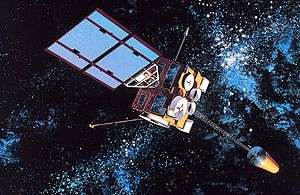GOES-U
GOES-U is a planned weather satellite, the fourth and last of the GOES-R series of satellites operated by the National Oceanic and Atmospheric Administration (NOAA). The GOES-R series will extend the availability of the Geostationary Operational Environmental Satellite (GOES) system until 2036. The satellite will be built by Lockheed Martin, based on the A2100 platform.[1]
| Mission type | Earth weather forecasting |
|---|---|
| Operator | NOAA / NASA |
| Mission duration | 15 years (planned) |
| Spacecraft properties | |
| Bus | A2100 |
| Manufacturer | Lockheed Martin |
| Launch mass | 2,800 kilograms (6,200 lb) |
| Start of mission | |
| Launch date | 2024 (planned) |
| Launch site | Cape Canaveral Air Force Station |
| Orbital parameters | |
| Reference system | Geocentric |
| Regime | Geostationary |
Launch
The satellite is expected to be launched into space sometime in 2024 from Cape Canaveral Air Force Station, Florida, United States.[2][3] The redesign of the loop heat pipe to prevent an anomaly, as seen in GOES-17, is not expected to delay the launch as it did with GOES-T.[4]
GOES-U will also carry a copy of the Naval Research Laboratory's Compact CORonagraph (CCOR) instrument which, along with the CCOR planned for SWFO-L1, will allow continued monitoring of solar wind after the retirement of the NASA-European Space Agency SOHO satellite in 2025.[5][6]
It will have a mass of 2,800 kg.[7]
References
- Mission overview; GOES-R. Retrieved 2016-11-28.
- Our Satellites NOAA, Retrieved March 5, 2017.
- Oswald, Ed (November 22, 2016). "Launch of GOES-R satellite a game-changing moment for weather forecasting". Digital Trends. Retrieved 29 November 2016.
- "Lockheed Martin halts work on GOES-T to wait for instrument fix". SpaceNews.com. 2019-01-09. Retrieved 2019-05-26.
- Vargas, Marco (7 January 2019). "The NOAA Space Weather Follow-On Program to Ensure Continuity of CME Imagery and Solar Wind Space-Based Observations". American Meteorilogical Society 99th Annual Meeting. AMS. Retrieved 24 March 2020.
- "Space Weather Follow-On". Office of Projects, Planning, and Analysis. NOAA National Environmental Satellite, Data, and Information Service (NESDIS). Retrieved 24 March 2020.
- Ray, Justin (22 August 2016). "Sophisticated new U.S. weather observatory being readied for launch". Spaceflight Now. Retrieved 19 October 2016.
